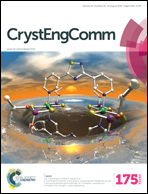Short C–H⋯F interactions involving the 2,5-difluorobenzene group: understanding the role of fluorine in aggregation and complex C–F/C–H disorder in a 2 × 6 isomer grid†
Abstract
A 2 × 6 isomer grid of six N-(difluorophenyl)benzamides (F2-xx) and six N-(phenyl)difluorobenzamides (xx-F2) (xx = 23/24/25/26/34/35) integrating crystal structure analyses (at 294 K), gas phase calculations and conformational analyses is reported. All 12 isomers (C13H9N1O1F2) aggregate via N–H⋯O![[double bond, length as m-dash]](https://www.rsc.org/images/entities/char_e001.gif) C intermolecular interactions and usually in combination with intermolecular C–H⋯O/F/π interactions and often F⋯F contacts. The F2-25 crystal structure has a remarkably supershort intermolecular C–H⋯F interaction for a neutral organic, while the 25-F2 (amide-bridged reversed) has an analogous short C–H⋯F in a twinned, disordered structure. The results demonstrate a promising 2,5-difluorobenzene effect being responsible for shorter C–H⋯F contacts than would normally be expected. An understanding of the relationships between F/H atom permutations in substituted difluorobenzenes is realised with the influence of fluorine substitution patterns on molecular aggregation rationalised in a series of twelve isomers.
C intermolecular interactions and usually in combination with intermolecular C–H⋯O/F/π interactions and often F⋯F contacts. The F2-25 crystal structure has a remarkably supershort intermolecular C–H⋯F interaction for a neutral organic, while the 25-F2 (amide-bridged reversed) has an analogous short C–H⋯F in a twinned, disordered structure. The results demonstrate a promising 2,5-difluorobenzene effect being responsible for shorter C–H⋯F contacts than would normally be expected. An understanding of the relationships between F/H atom permutations in substituted difluorobenzenes is realised with the influence of fluorine substitution patterns on molecular aggregation rationalised in a series of twelve isomers.


 Please wait while we load your content...
Please wait while we load your content...